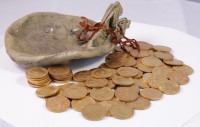 Last November, piano tuner Martin Backhouse was having a hard time with some sticky keys on a 1906 Broadwood & Sons upright piano he was overhauling for The Community College of Bishops Castle. Martin found the problem when he removed the keys: eight parcels full of gold coins.
Last November, piano tuner Martin Backhouse was having a hard time with some sticky keys on a 1906 Broadwood & Sons upright piano he was overhauling for The Community College of Bishops Castle. Martin found the problem when he removed the keys: eight parcels full of gold coins.
The school alerted the Finds Liaison Officer for the region, Peter Reavill, and he and his colleagues at the Portable Antiquities Scheme examined and catalogued the hoard. Inside seven cloth-wrapped parcels and one suede drawstring pouch, they counted 913 gold sovereigns and half-sovereigns ranging in date from 1847 to 1915, issued in the reigns of Queen Victoria, Edward VII and George V. The weight of the coins totals more than 6 kilos (13+ pounds) of gold bullion.
 One of the pouches was packed with cardboard that provided an important clue to when the hoard was hidden. It was an ad for Shredded Wheat created after 1926 and likely before 1946. Attempts to trace the ownership history of the piano to determine who might have stashed the coins inside it went nowhere. After its manufacture by Broadwood & Sons of London, it was sold to music teachers Messrs. Beavan & Mothersole of Saffron Walden, Essex. There is no trace of its movements for almost 80 years. The trail picks up again in 1983 when it was acquired by Mr. and Mrs. Hemming, also of Saffron Walden, for the children to learn on. It remained with the Hemmings until last year when they donated it to the Bishops Castle Community College.
One of the pouches was packed with cardboard that provided an important clue to when the hoard was hidden. It was an ad for Shredded Wheat created after 1926 and likely before 1946. Attempts to trace the ownership history of the piano to determine who might have stashed the coins inside it went nowhere. After its manufacture by Broadwood & Sons of London, it was sold to music teachers Messrs. Beavan & Mothersole of Saffron Walden, Essex. There is no trace of its movements for almost 80 years. The trail picks up again in 1983 when it was acquired by Mr. and Mrs. Hemming, also of Saffron Walden, for the children to learn on. It remained with the Hemmings until last year when they donated it to the Bishops Castle Community College.
On April 20th, John Ellery, senior coroner for Shropshire, held an inquest in Shrewsbury and declared the gold coins treasure according to the 1996 Treasure Act, which means they now officially belong to the Crown. The British Museum will convene a Treasure Valuation Committee to assess the market value of the coins. Local museums will be given the chance to acquire the hoard for the assessed sum, which will then be split between finder Martin Backhouse and the piano’s owners, the Bishops Castle Community College.
 Coins made of precious metals that are more than 300 years old qualify as treasure, but these coins are comparatively recent. The determination that they are treasure is based on three criteria: 1) they are made of gold, 2) they were deliberately hidden with the ultimate aim of recovering them at a later date, 3) the owner and/or heirs are unknown. This was the standard applied to the Hackney Double Eagle hoard discovered in a London backyard in 2010, whose coins are also gold and have almost the exact same date range (1854-1913). The publicity from that case resulted in the identification of the legitimate owner, the son of the original owner who had died in 1981.
Coins made of precious metals that are more than 300 years old qualify as treasure, but these coins are comparatively recent. The determination that they are treasure is based on three criteria: 1) they are made of gold, 2) they were deliberately hidden with the ultimate aim of recovering them at a later date, 3) the owner and/or heirs are unknown. This was the standard applied to the Hackney Double Eagle hoard discovered in a London backyard in 2010, whose coins are also gold and have almost the exact same date range (1854-1913). The publicity from that case resulted in the identification of the legitimate owner, the son of the original owner who had died in 1981.
That has not happened in this case, despite the coroner adjourning the inquest twice to give any potential claimants the chance to come forward. Surprising absolutely nobody, many claimants came forward, almost 50 of them, hoping to get their hands on some of that sweet, sweet gold sovereignage, but no evidence was found to substantiate any of the claims, hence the treasure verdict.
This video from the British Museum’s YouTube channel tells the story of the Piano Hoard.
[youtube=https://youtu.be/I2dY_wgVK0I&w=430]